Customer Warnings - Overview
Customer warnings offer a way to highlight customers that are on hold, or have a zero or negative available balance.
These warnings will be shown prominently on the Customer Record, as well as in the following areas:
- Opportunity
- Quotation
- Sales Order
These warnings will not prevent any actions from occurring in The Layer e.g. quotation or order creation - they are intended only to make the user aware.
Balance Warning
If enabled, this warning will display on customer, quotation and sales order records in the event that the available balance is zero or negative.
Defining "Available Balance"
There are a three variables that can be used to define "Available Balance", and determine if sufficient credit is available:
- Account Balance
- Credit Limit (optional)
- Fund Balance (optional)
Additionally, you may choose to deduct the value of open sales orders from this figure.
Please see the "Customisation" section below for details on configuring this calculation.

On Hold Warning
You may choose to display a warning that a customer is on hold. This will show on customer, quotation and sales order records and creation dialogues.
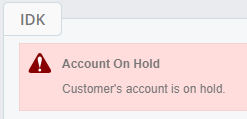
By default, this is based on the "Account on Hold" field on the Customer Record. Alternatively, Sage integration users can use the status from Sage instead. Please see the "Integrations" subsection under the next section for details.
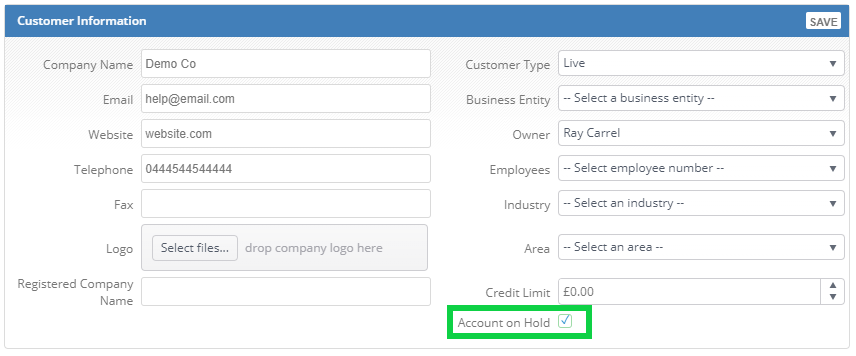
Enabling Warnings
Users with Settings access can enable these warnings from:
Settings - Company Setup - Finance - Customer Balance Warning Components

The "Account Status" widget can also be enabled here. It will display various values pertaining to customer warnings. See below before more details.
Integrations
If your instance of The Layer is integrated with either Sage 200 or Sage Intacct, you can elect to pull some of these values from those systems instead of The Layer.

Balance Warnings - Customisation
You can customise the balance check from:
Settings - Company Setup - Finance - Customer Balance Warning Components
Transaction Parts
The options enabled here will determine the calculation used for a customer's balance.
- Include Credit Limit
- Include Funds
- Deduct Open SO Value from Available Balance
Any options that are ticked will be added to or deducted from the customer's account balance. A preview of the calculation is shown.
"Include Funds" refers to any unused funds on the customer's account. You will not be able to select this option if you are using The Layer's current balance as your Account Balance, as this already takes unused funds into account.

Account Balance
This can be taken from The Layer's customer record, or from your Sage record. If you are using values from The Layer, you can choose to use the customer's invoice balance or the account balance.
Available options:
Integration Account BalanceTake the Account Balance as it is shown in Sage 200 or Intacct.
Layer Current Balance Including Open Sales Order Transactions
Take the Current Balance as seen in the Customer Balances widget on a customer record, as well as the value of any sales orders that are not in a Completed state.
Layer Current Balance Excluding Open Sales Order Transactions
Take the Current Balance as seen in the Customer Balances widget on a customer record.
Layer Invoice Balance Including Open Sales Order Transactions
Use the total remaining balance on invoices for all orders.
Layer Invoice Balance Excluding Open Sales Order Transactions
Use the total remaining balance on invoices for orders in a Completed state only.
Credit Limit
This can be taken from The Layer's customer record, or from your Sage record. To view or edit this value in The Layer, the user must have the user role "Allow Customer Credit Limit Changes" enabled.
Funds
You can choose to include any of the following fund types:
- Buyout
- Hardware
- Subsidy
- General
Order Parts
If you decide to deduct open sales order values from the credit total, you have options regarding how this value is calculated:
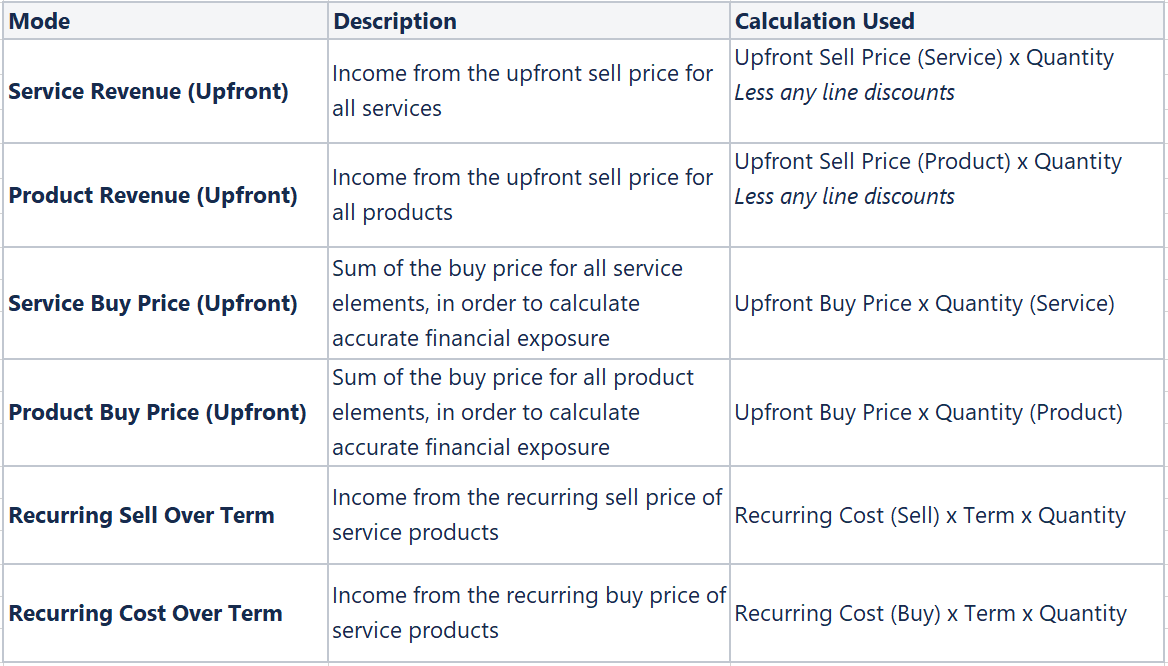
You can select multiple options, but selecting one option will render incompatible options unselectable. This is to help ensure that your calculation makes sense.
For users without Sage integration, the options you decide to use will depend on what suits your organisation. You may wish to consider only upfront revenue, or you may prefer to use buy prices.
Account Status Widget
The "Account Status" widget will display information 

Note for Sage Integration Users
If you are using our Sage 200 or Intacct integration, you can see the Sage balances widget below the Account Status widget. The cloud icon can be clicked to store those values in the equivalent Layer customer record fields.
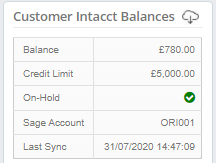
Deciding on a Configuration
The configuration that suits you will depend on your own preferences. However, some suggested configurations have been provided:
Sage Integration Balance, with The Layer Funds and Open Sales Orders
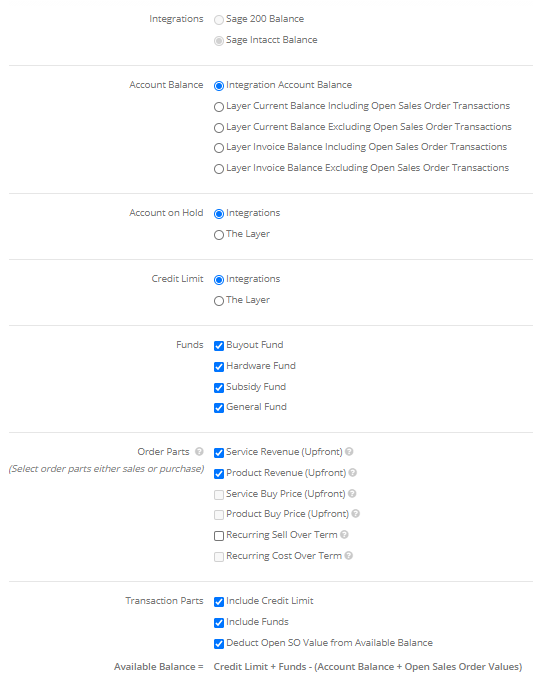
This would use the Sage balance (e.g. outstanding invoice balance), but also include any unused funds from The Layer. Open Sales Order Value would also be taken from The Layer, based on any upfront costs.
This would use Sage as the main data source but would include exposure from open sales orders in The Layer. Please note that Orders in a Completed state would not be included in this balance.
Invoice Balance, with Credit Limit Where Applicable

We use The Layer's outstanding invoice balance as the Account Balance. Where a Credit Limit has been set for a customer, this will be included.
This is a simple configuration, taking only a customer's outstanding invoice balance into account, regardless of sales order status. Draft invoices could be created without affecting the Available Balance.
Layer Balance - Simple
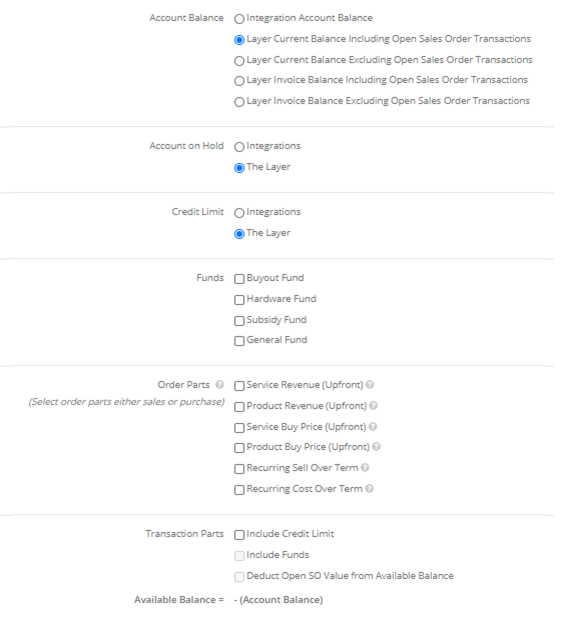
Here we use the Current Balance from The Layer, reflecting what is seen in the Customer Balances widget. This already takes invoices and unused funds into account.
Orders will not affect the Available Balance until invoiced, or funds are converted.






